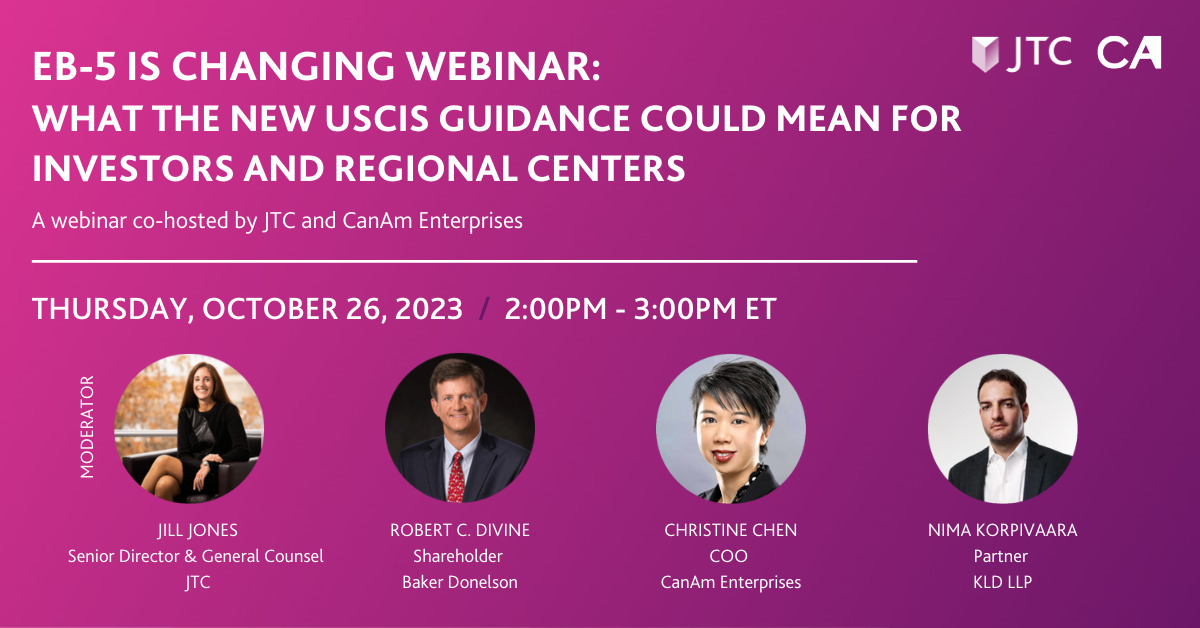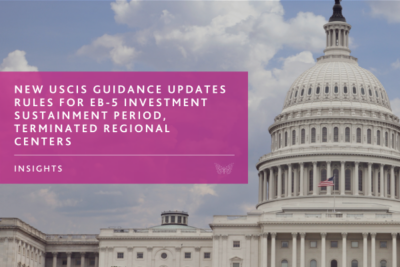H-1B Lottery Uncertainty
For thousands of highly skilled professionals, the annual H-1B lottery feels like a game of chance that can dictate their entire future in the United States. This year is no different. With demand far outpacing the 85,000 available H-1B slots, many talented individuals find themselves at a crossroads, asking: “Now what?”
In a webinar hosted by CanAm Enterprises and the Galati Law Firm, Pete Calabrese, CEO of CanAm Investor Services, and leading immigration attorney Matt Galati explored that very question—and why the EB-5 Immigrant Investor Program might be a powerful alternative for those left without options.
A Program Where You Control Your Immigration Future
“What I love about EB-5,” said Matt Galati, “is that it gives immigrants the most control over their outcomes.”
Unlike employer-sponsored visas, EB-5 doesn’t rely on chance or the discretion of a sponsoring company. “So much of the U.S. immigration system is built on things you can’t control,” Galati explained. “You can’t control where you’re born. You can’t control whether you get picked in the H-1B lottery. EB-5, on the other hand, is one of the few categories where if you meet the requirements, you can move forward with a clear roadmap.”
Understanding EB-5: A Quick Primer
The EB-5 program allows foreign nationals to obtain a green card by making an investment in a U.S. commercial enterprise that creates at least 10 full-time American jobs. Most investors opt to invest through a USCIS-approved Regional Center, such as CanAm Enterprises, which has facilitated over 70 projects and raised more than $3.7 billion in EB-5 capital.
“Through Regional Centers,” Galati explained, “you can leverage indirect job creation, like construction labor or economic impact, which makes participation much more accessible compared to starting your own business.”
The standard minimum investment is $1.05 million. However, if the project is in a Targeted Employment Area (TEA)—typically a rural or high-unemployment area—the minimum drops to $800,000. “In 12 years, I’ve never had a client choose to go the $1.05 million route,” Calabrese noted. “Everyone uses the TEA investment because of the lower threshold.”
Read More: CanAm Enterprises Successfully Completes 2024 Audit, Reinforcing Commitment to Investor Success
A Pathway to Interim Benefits—and Flexibility
A major shift in the EB-5 landscape came with the passage of the Reform and Integrity Act (RIA) of 2022. One of its most significant enhancements? The ability for certain EB-5 investors already in the U.S. to file their I-485 adjustment of status application concurrently with their I-526E petition.
“Concurrent filing is a game-changer,” said Galati. “You can apply for a work permit (EAD) and travel authorization (Advance Parole) right away. Once approved, that EAD lets you work anywhere—from McDonald’s to NASA. You can even start your own business.”
These interim benefits allow investors to live and work in the U.S. while waiting for their green card to be processed—a huge advantage, especially for those whose current visa status is expiring or who were not selected in the H-1B lottery.
What About Processing Times?
There’s good news here too. According to Galati, “I-526E petitions under the new law are moving much faster than before. We’ve seen approvals in as little as one month.” For those investing in rural projects, which receive “priority processing,” timelines could be even shorter.
For adjustment of status benefits, Galati noted: “We’re seeing EADs granted in three to six months and travel documents in three to twelve months.”
But What If I Don’t Have $800,000?
Not everyone has that kind of liquidity—especially younger professionals just starting their careers. That doesn’t mean EB-5 is out of reach.
“We’ve filed successful EB-5 petitions for students, even some still in college,” Galati said. “In those cases, the source of funds might be a gift from parents or the proceeds of mortgaging or selling property. The key is that the money must be lawfully sourced and thoroughly documented.”
Calabrese likened the process to a “forensic audit,” where every dollar must be traced. “It’s a heavy lift,” Galati joked, recalling a recent 45-pound petition they had to haul to FedEx.
Getting Started: The Two Most Important Decisions
When it comes to launching your EB-5 journey, both experts agreed on the most crucial early steps: “You need to pick the right regional center and the right immigration attorney,” Calabrese said. “Everything else builds from there.”
“Your immigration lawyer should be your quarterback,” added Galati. “But they aren’t financial advisors. They’ll focus on compliance, sourcing of funds, and ensuring the offering documents are legally sound. For everything else—like understanding the risk of the investment or how you’ll get your money back—that’s where working with a reputable regional center matters.”
A Long-Term Investment in Your Future
Calabrese was clear about what CanAm prioritizes. “This is a long-term relationship. Our mission is to help investors secure U.S. permanent residency and ensure the safe return of their capital. That’s why working with trusted, experienced professionals matters.”
At the end of the day, Galati offered a final piece of encouragement: “You can’t control the H-1B lottery—that’s the nature of a lottery. But with EB-5, you have a real chance to take your immigration destiny into your own hands.”
Want to Learn More?
Reach out to CanAm Investor Services to explore whether EB-5 is the right path for your future in the U.S. It might just be the opportunity you’ve been waiting for.




